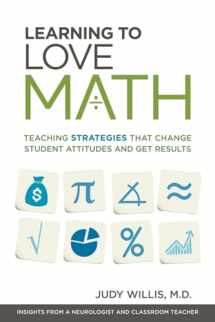
Learning to Love Math: Teaching Strategies That Change Student Attitudes and Get Results
Book details
Summary
Description
Is there a way to get students to love math? Dr. Judy Willis responds with an emphatic yes in this informative guide to getting better results in math class. Tapping into abundant research on how the brain works, Willis presents a practical approach for how we can improve academic results by demonstrating certain behaviors and teaching students in a way that minimizes negativity.
With a straightforward and accessible style, Willis shares the knowledge and experience she has gained through her dual careers as a math teacher and a neurologist. In addition to learning basic brain anatomy and function, readers will learn how to
* Improve deep-seated negative attitudes toward math.
* Plan lessons with the goal of achievable challenge in mind.
* Reduce mistake anxiety with techniques such as errorless math and estimation.
* Teach to different individual learning strengths and skill levels.
* Spark motivation.
* Relate math to students personal interests and goals.
* Support students in setting short-term and long-term goals.
* Convince students that they can change their intelligence.
With dozens of strategies teachers can use right now, Learning to Love Math puts the power of research directly into the hands of educators. A Brain Owner s Manual, which dives deeper into the structure and function of the brain, is also included providing a clear explanation of how memories are formed and how skills are learned. With informed teachers guiding them, students will discover that they can build a better brain . . . and learn to love math!


We would LOVE it if you could help us and other readers by reviewing the book
Book review



